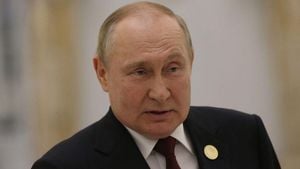Anticipation looms over Europe as the political scenery shifts dramatically with Donald Trump’s recent victory. His ascendance to the presidency is positioned to have far-reaching consequences, particularly concerning the security and defense policies not just of Europe, but also of the transatlantic alliance. With tensions running high due to the situation in Ukraine and threats posed by Russia, European leaders are shifting their focus to fortifying their defenses just as the prospect of reduced American support becomes more tangible.
U.S. Secretary of State Antony Blinken recently made headlines with his emergency visit to Brussels, focusing on ensuring unwavering support for Ukraine amid fears of potential shifts in U.S. policy following Trump's return to power. After touching down late Tuesday, Blinken met with key NATO and EU officials, including NATO chief Mark Rutte and EU diplomacy boss Josep Borrell, aiming to devise strategies to support Kyiv as it continues to grapple with the Russian invasion.
Trump’s past statements have raised alarms across Europe—particularly his admiration for Russian President Vladimir Putin and his dismissal of the substantial U.S. financial commitments to Ukraine since the onset of the conflict, totaling around $175 billion. The former president has suggested he could negotiate peace rapidly, potentially at Ukraine's expense. Coupled with increasing insights about North Korean military personnel joining Russian efforts, the stakes feel perilous.
European officials are evidently on high alert. Rutte highlighted the necessity for the EU to remain steadfast and prepare for what could be the most brutal winter since the onset of the conflict. His concerns are echoed by other European leaders about maintaining unity and support, especially with Trump’s unpredictability steering the U.S. foreign policy wheel once more.
Compounding the tension is the announcement from Brussels about freeing up billions of euros to redirect to defense budgets amid the Ukrainian conflict. The European bloc is modifying its budgetary structure, tapping cohesion funds to bolster military expenditures. This strategic pivot aligns with increased demands for NATO allies to step up their defense commitments, especially as Trump has previously pressured European nations to boost military spending to meet NATO’s target of 2% of GDP.
Since Trump’s first term, many NATO members have adjusted their defense budgets accordingly. Notably, this year saw European NATO countries responding to Trump's pressure by increasing their spending substantially, particularly following Russia's full-scale invasion of Ukraine. Currently, 23 countries are on track to allocate at least 2% of their GDP to defense by 2024, with the likes of Poland and the Baltic states leading the charge.
Despite the notable increases, experts caution against underestimations of Trump's stance. Some analysts, including Paal Sigurd Hilde from the Norwegian Institute for Defense Studies, note the pressure Trump could place on NATO allies should he advocate for stringent spending thresholds which might not align with all members’ capabilities or interests. Hilde stressed, “We should not underestimate how effective Trump's pressure has been” and underscored the importance of Norway finally committing to defense budget goals.
While the political dynamics within Europe are adjusting to Trump’s re-election, so too are the ramifications felt by Ukraine. Ukrainian leadership has consistently voiced the urgency for more military support from European allies, particularly as Trump appears poised to recalibrate U.S. assistance strategies. Ukraine’s President, Volodymyr Zelensky, has appealed for more decisive action from Europe—noting their military assistance is imperative as they brace for potential escalations.
Simultaneously, there’s heightened collaboration between the UK and EU, as they expedite work on defense pacts to solidify their stances against potential Russian aggressions. Both parties recognize the necessity of maintaining unity and support, emphasizing the need to raise costs for adversaries like Putin—consistently advocating for continued military aid to Ukraine.
Complications arise, though, with the knowledge of Russia actively bolstering its military thanks to support from allies like North Korea and Iran. The evolution of this trilateral cooperation may possess far-reaching consequences for European security. Analysts warn this collaboration could compromise the region's safety, as increasingly adept Russian capabilities may emerge from this alliance.
Further complicity exists with China’s burgeoning relationship with Russia. If Beijing were to significantly provide military backing, the balance of power might shift swiftly. If there’s any indication from Trump’s previous tenure, it could imply less U.S. focus on Europe and more attention to the Indo-Pacific, drawing resources away from Europe. Consequently, Europe may have to intensify its military spending and develop its capabilities independently.
The United States remains committed to supporting NATO. Experts like Øystein Tunsjø believe the risk of Trump withdrawing the U.S. from NATO is low, due primarily to domestic and military pushback. Nevertheless, should he proceed to vocalize skepticism about NATO’s collective defense principles, or turn away from Europe as the primary focus, it may introduce fractures within the alliance. Tunsjø estimated, “Regardless of who was elected president, both candidates would prepare for a potential long-term conflict with China,” demonstrating the shifting narrative with China taking the center stage on U.S. foreign policy.
While realignment efforts are underway, one cannot overlook the various internal factors affecting NATO’s credibility and reliability. With Trump intent on portraying toughness, experts predict he may leverage past states of affairs to criticize European allies for their defense spending. The complexity of maintaining transatlantic relationships hinges on Europe’s willingness to independently establish military preparedness.
Capitalizing on this pivot, European nations have firmly grasped the necessity for stronger military budgets to deter any threat from Russia. Experts anticipate military spending will rise significantly, with estimates positing potential increases of up to 18% next year. This collective effort is particularly significant for members who have historically been underfunded compared to their American counterparts.
With the foundation laid, Europe now faces the task of building long-term resilience. Despite increased spending, key figures like Hilde noted challenges still lie within the political will to form cohesive alliances based on mutual respect and trust. The integrity of NATO depends on the willingness of its members to unite forces and commit to collective defense. That spirit stands at risk, leading some analysts to note Trump’s re-election will likely spark renewed calls for increased spending from the U.S. on their defense commitments.
Looking beyond the immediate future, the question looms: can Europe prepare adequately for the possible tumultuous years under Trump's leadership? With the specter of economic instability and potential conflict ever-present, Europe stands at the crossroads of either succumbing to divisions or fostering solidarity amid common threats. The challenge lays not just within enhancing budgets, but also engaging collectively to define their security interests—which remain increasingly intertwined amid today’s geopolitical quagmire.



